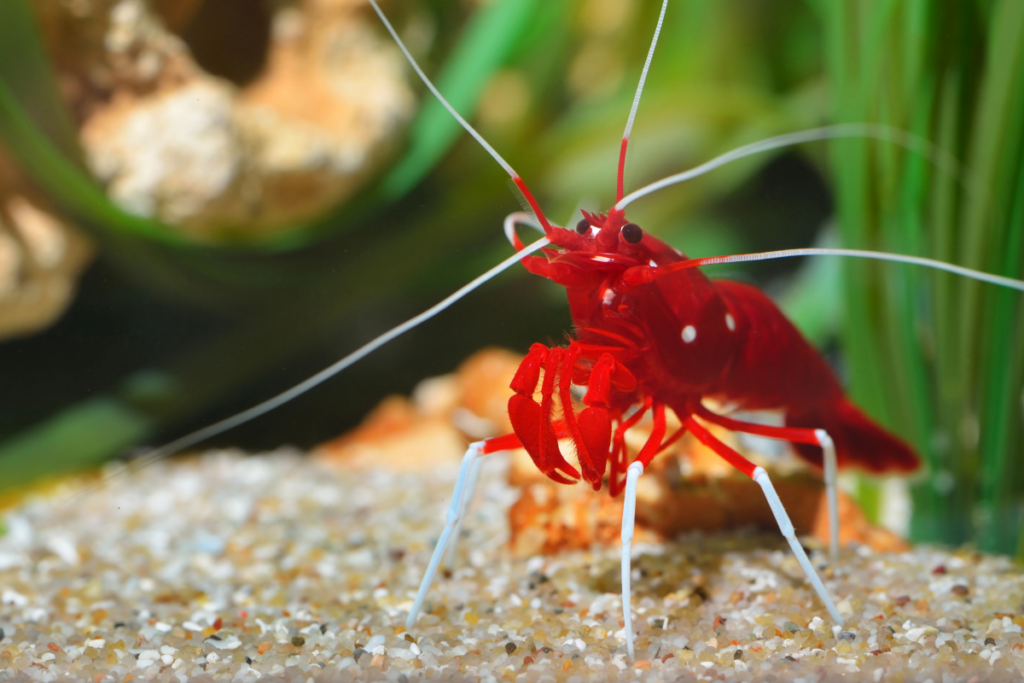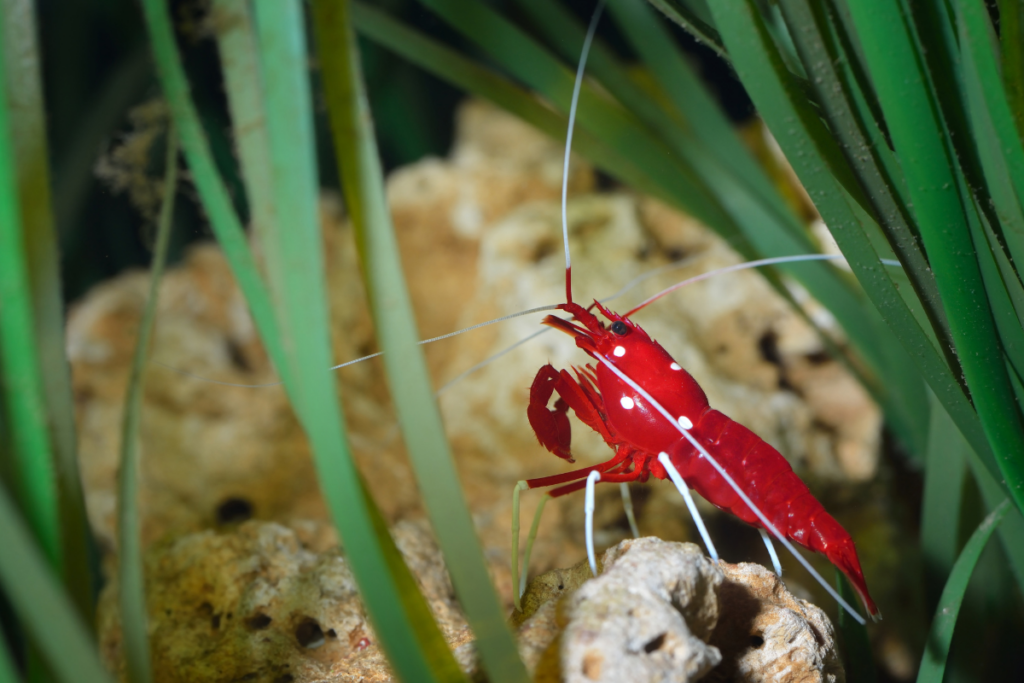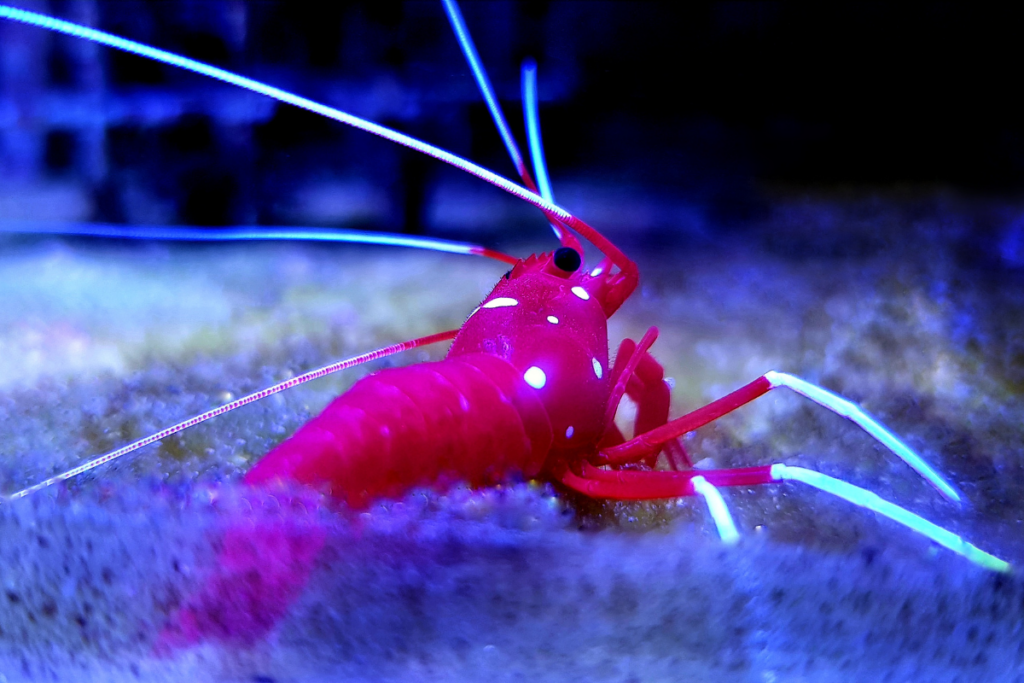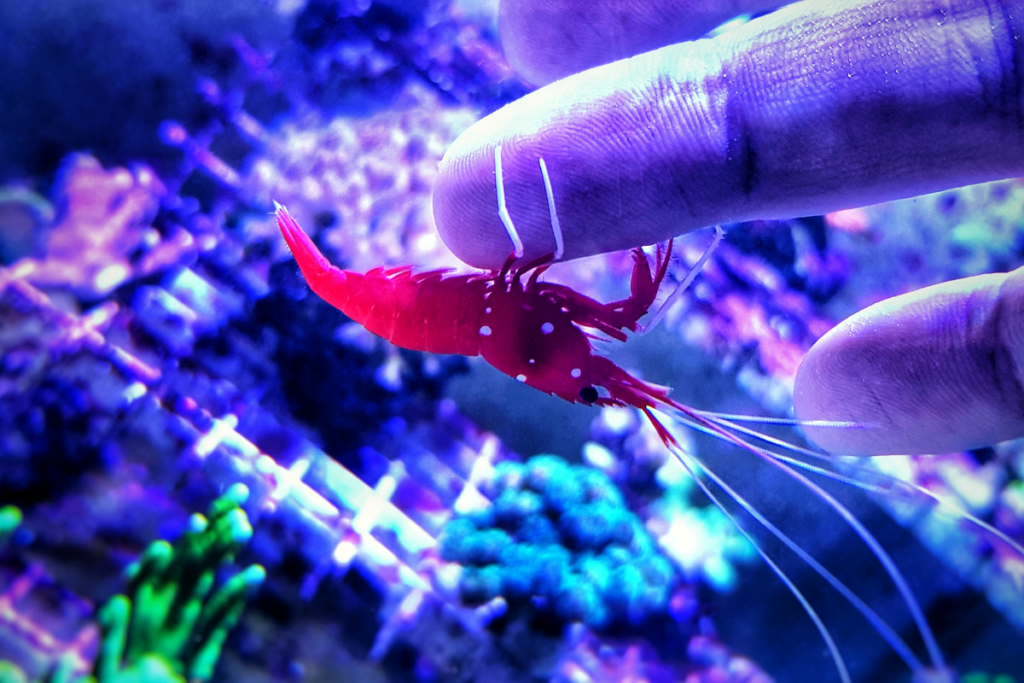If you’re looking for an interesting and unique addition to your aquarium, Caridina dennerli shrimp may be just what you need. These small, colorful creatures are native to Sulawesi, an island in Indonesia, and are highly sought after by shrimp enthusiasts around the world. In this article, we’ll cover everything you need to know about Caridina dennerli shrimp care, from their habitat requirements to their feeding habits.
Caridina dennerli is a small, freshwater shrimp species that requires a minimum tank size of 10 gallons. They prefer a pH range of 6.0-6.5 and soft water. They are omnivorous and should be fed a varied diet of algae, biofilm, and prepared foods. Regular water changes and proper filtration are necessary for their well-being.
When I first got into shrimp keeping, I was immediately drawn to the striking appearance of Caridina dennerli. Their bright red and white coloration is truly eye-catching, and I knew I had to have them in my tank. However, I quickly realized that they require a bit more specialized care than some other types of shrimp. But don’t worry – with the right setup and attention to detail, you can successfully keep and breed these fascinating creatures.
In this article, we’ll cover all the basics of Caridina dennerli shrimp care, including water parameters, tank setup, feeding, and breeding. Whether you’re a seasoned shrimp keeper or just starting out, you’ll find plenty of useful information to help you give your Caridina dennerli the best possible care.

Table of Contents
Species Summary
If you’re looking for a unique and fascinating addition to your aquarium, Caridina dennerli shrimp may be just what you’re looking for.
These little creatures are also known as “Bee Shrimp” due to their black and yellow stripes, and they make for a colorful and interesting addition to any tank.
Here’s what you need to know about Caridina dennerli shrimp care.
Origin
Caridina dennerli shrimp are native to Sulawesi, an island in Indonesia.
They are found in freshwater streams and rivers in the area, and are a relatively new addition to the aquarium hobby.
Lifespan
Caridina dennerli shrimp have a lifespan of around 1-2 years, depending on the conditions in your tank.
With proper care, you can help ensure that your shrimp live a long and healthy life.
Appearance
Caridina dennerli shrimp are small and colorful, with black and yellow stripes that resemble those of a bee.
They have a slender body and long antennae, and are a striking addition to any aquarium.
Size
Adult Caridina dennerli shrimp typically reach a size of around 1.5 inches, making them a small but eye-catching addition to your tank.
Growth Rate
The growth rate of Caridina dennerli shrimp can vary depending on the conditions in your tank.
With proper care and a healthy diet, you can expect your shrimp to grow at a steady rate.
Behavior & Temperament
Caridina dennerli shrimp are peaceful creatures that do well in a community tank with other non-aggressive species.
They are active and curious, and will spend much of their time exploring their surroundings and foraging for food.
Male vs Female
Male and female Caridina dennerli shrimp are similar in appearance, but females are typically larger and more robust than males.
Females also have a saddle-shaped marking on their backs, which is where they carry their eggs.
When I first added Caridina dennerli shrimp to my tank, I was amazed by their vibrant colors and active behavior.
Watching them explore their new home was a joy, and I quickly became attached to these fascinating little creatures.
With proper care and attention, you too can enjoy the beauty and personality of Caridina dennerli shrimp in your own aquarium.
Tank Setup
Tank Size
When it comes to keeping Caridina dennerli shrimp, the size of your tank is crucial. You’ll want to make sure you have enough space for your shrimp to move around and explore.
A good rule of thumb is to have a tank that’s at least 10 gallons. However, if you plan on keeping a larger number of shrimp, you’ll need a bigger tank.
Keep in mind that the more shrimp you have, the more filtration and maintenance your tank will require.
Lighting
Caridina dennerli shrimp prefer dim lighting, so it’s best to keep your tank out of direct sunlight.
You can use a low-wattage aquarium light to provide some illumination, but make sure it’s not too bright. Too much light can cause algae growth and stress out your shrimp.
Filtration & Aeration
A good filtration system is essential for keeping your tank clean and your shrimp healthy.
A sponge filter is a great option for Caridina dennerli shrimp since it provides gentle water flow and won’t suck up any baby shrimp.
Aeration is also important to ensure there’s enough oxygen in the water. You can use an air stone or a small powerhead to create some water movement.
Heater
Caridina dennerli shrimp are sensitive to temperature changes, so it’s important to keep your tank at a consistent temperature between 72-78°F.
A heater can help you maintain a stable temperature and prevent any fluctuations that could harm your shrimp.
Substrate
A good substrate for Caridina dennerli shrimp is a fine-grained, inert substrate like sand or gravel. Avoid using substrates that can alter the pH or hardness of your water, as these can be harmful to your shrimp.
Decoration
Adding decorations to your tank can provide hiding places for your shrimp and make the tank more visually appealing.
However, make sure any decorations you add are shrimp-safe and won’t leach harmful chemicals into the water.
Plants
Live plants are a great addition to any shrimp tank, as they provide natural filtration and oxygenation. Some good plant options for Caridina dennerli shrimp include Java moss, Anubias, and Marimo moss balls. Just make sure any plants you add are compatible with your shrimp and won’t require too much maintenance.

I remember when I first set up my Caridina dennerli shrimp tank. I spent hours researching the best tank setup and making sure everything was just right.
It was a lot of work, but seeing my shrimp thrive in their new home made it all worth it. With the right tank setup, you can provide your shrimp with a safe and healthy environment to thrive in.
Water Quality
When it comes to Caridina dennerli shrimp care, water quality is crucial.
These shrimp are sensitive to changes in their environment, so it’s important to maintain stable water parameters to ensure their health and well-being.
Water Temperature
The ideal water temperature for Caridina dennerli shrimp is between 72°F and 78°F (22°C-26°C).
Keep in mind that sudden temperature changes can be stressful for them, so it’s important to avoid drastic fluctuations.
Water pH
The optimal pH for Caridina dennerli shrimp is between 6.0 and 6.8. It’s important to note that these shrimp are sensitive to pH changes, so it’s best to avoid sudden fluctuations.
Additionally, it’s important to avoid using chemicals to adjust pH as this can harm the shrimp.
Water Hardness
Caridina dennerli shrimp require soft water with a hardness between 2 and 6 dGH. Hard water can be harmful to their health and can even cause death.
If your water is too hard, consider using a reverse osmosis (RO) unit to soften it.
Water Changes
Regular water changes are crucial for maintaining water quality for Caridina dennerli shrimp. Aim to change 10-20% of the water every week to keep the water clean and fresh.
When doing water changes, make sure to use a water conditioner to remove any harmful chemicals such as chlorine and chloramines.
Personally, I’ve found that keeping a log of my water parameters and water change schedule has been helpful in maintaining stable water quality for my Caridina dennerli shrimp.
By doing so, I can easily identify any changes or issues, and address them promptly.
Tank Maintenance
Keeping your Caridina dennerli shrimp healthy and happy requires regular tank maintenance. Here are a few tips to keep in mind:
You should perform a partial water change every week to keep the water clean and fresh. I recommend changing 10-20% of the water each time.
This will help remove any excess waste and debris that could harm your shrimp. Be sure to use a water conditioner to remove any harmful chemicals from your tap water.
It’s also important to keep the tank clean. I like to use a small siphon to remove any leftover food or waste that accumulates on the bottom of the tank.
This helps prevent the growth of harmful bacteria and keeps the water quality high.
Regularly testing the water parameters is crucial for the health of your shrimp. You should test for ammonia, nitrite, nitrate, pH, and GH (general hardness) levels.
Aim for an ammonia and nitrite level of 0 ppm, a nitrate level below 20 ppm, a pH level between 6.5 and 7.5, and a GH level between 4 and 6 dGH.
Keep in mind that Caridina dennerli shrimp prefer soft water, so it’s important to monitor the GH levels carefully.
Finally, make sure to keep the tank temperature stable. Caridina dennerli shrimp prefer a temperature between 72-78°F (22-26°C).
Fluctuations in temperature can stress the shrimp and make them more susceptible to disease. You can use a heater and thermometer to maintain a consistent temperature.
Tank Mates
If you’re considering adding Caridina dennerli shrimp to your aquarium, it’s important to know which fish species are compatible and which are not. Here are some things to keep in mind:
Compatible Fish Species
Caridina dennerli shrimp are peaceful creatures that do well with other small, non-aggressive fish. Some suitable tank mates include:
- Neon tetras
- Cherry barbs
- Otocinclus catfish
- Corydoras catfish
These fish won’t bother your shrimp and will help keep the tank clean. Just be sure to provide plenty of hiding places for your shrimp so they can feel safe.
Incompatible Fish Species
There are also some fish species that are not suitable tank mates for Caridina dennerli shrimp. These include:
- Cichlids
- Gouramis
- Betta fish
- Angelfish
These fish are known to be aggressive and may attack or eat your shrimp. It’s best to avoid keeping them together.
How Many Caridina Dennerli Should I Get?

When it comes to the number of Caridina dennerli shrimp to add to your tank, it’s important to keep in mind that they are social creatures and do best in groups.
A good rule of thumb is to have at least six shrimp per tank, but more is always better.
Personally, I started with just a few shrimp in my tank and quickly fell in love with their unique personalities. Now, I have a thriving colony of Caridina dennerli shrimp that bring me joy every day.
Diet
Proper diet is essential for the health and longevity of Caridina dennerli shrimp. In this section, we will cover what to feed your shrimp, how often to feed them, and some tips for maintaining a healthy diet.
What To Feed
Caridina dennerli shrimp are omnivorous, meaning they eat both plant and animal matter.
In the wild, they feed on biofilm, algae, and small aquatic invertebrates. In captivity, you can feed them a variety of foods, including:
- Algae wafers
- Shrimp pellets
- Bloodworms
- Daphnia
- Blanched vegetables such as zucchini or spinach
It is important to provide a balanced diet to ensure your shrimp receive all the necessary nutrients.
Frequency
Feed your Caridina dennerli shrimp once or twice a day, only as much as they can consume within a few hours.
Overfeeding can lead to poor water quality and health problems for your shrimp.
Tips
Here are some tips to keep in mind when feeding your Caridina dennerli shrimp:
- Rotate their diet to provide variety and ensure they receive all necessary nutrients.
- Remove any uneaten food after a few hours to prevent it from decomposing and polluting the water.
- Consider feeding your shrimp at night when they are most active.
- Observe your shrimp’s behavior and adjust their diet as needed.
Personally, I have found that my Caridina dennerli shrimp are particularly fond of blanched spinach. They swarm around it as soon as I drop it in the tank!
Common Diseases
Diseases
Caridina dennerli shrimp are generally hardy and can tolerate a wide range of water conditions. However, they are still susceptible to some diseases.
The most common diseases that affect Caridina dennerli shrimp are bacterial infections, fungal infections, and parasitic infections.
Symptoms
If you notice that your Caridina dennerli shrimp are not acting normally, it may be a sign that they are sick. Symptoms of bacterial infections include lethargy, loss of appetite, and discoloration.
Fungal infections can cause white, cotton-like growths on the shrimp’s body. Parasitic infections can cause the shrimp to become thin and weak.
Treatment
If you suspect that your Caridina dennerli shrimp are sick, it is important to act quickly.
Bacterial infections can be treated with antibiotics, while fungal infections can be treated with antifungal medication.
Parasitic infections can be treated with anti-parasitic medication. It is important to follow the instructions on the medication carefully to ensure that your shrimp recover fully.
Prevention
The best way to prevent diseases in your Caridina dennerli shrimp is to maintain a clean and healthy environment. Make sure that the water in your tank is clean and well-filtered.
Avoid overcrowding your tank, as this can lead to stress and disease. Quarantine any new shrimp that you introduce to your tank for at least two weeks to ensure that they are healthy before adding them to your main tank.
I have found that the best way to prevent diseases in my Caridina dennerli shrimp is to maintain a consistent water change schedule.
I change 20% of the water in my tank every week to keep the water clean and healthy.
By following these simple steps, you can help ensure that your Caridina dennerli shrimp stay healthy and happy.
Signs of a Healthy Caridina dennerli

When it comes to keeping Caridina dennerli shrimp, it is important to know what a healthy shrimp looks like. Here are some signs that your shrimp is healthy:
- Active and Responsive: A healthy shrimp will be active and responsive. They will move around the tank, explore their surroundings, and respond to stimuli.
- Clear and Bright Coloration: A healthy Caridina dennerli shrimp will have clear and bright coloration. Their colors will be vibrant and consistent throughout their body.
- Smooth and Shiny Shell: A healthy shrimp will have a smooth and shiny shell. Their shell should not have any cracks, scratches, or discoloration.
- Full and Rounded Body: A healthy shrimp will have a full and rounded body. Their body should not be sunken in or appear thin.
- Regular Molting: A healthy shrimp will go through regular molting cycles. Molting is a natural process where shrimp shed their old exoskeleton and grow a new one. If your shrimp is molting regularly, it is a sign that they are healthy and growing.
I remember when I first started keeping Caridina dennerli shrimp, I was so worried about their health. I would constantly check on them and make sure they were okay.
But over time, I learned what a healthy shrimp looks like and now I can easily identify any issues that may arise.
It’s important to keep an eye on your shrimp’s health, but don’t stress too much! With proper care, your Caridina dennerli shrimp will thrive.
Signs Your Caridina dennerli is Sick
If you’re a proud owner of Caridina dennerli shrimp, you want to make sure they are healthy and happy. Here are some signs that your shrimp may be sick:
- Decreased appetite: If your shrimp aren’t eating as much as they used to, it could be a sign of illness.
- Unusual behavior: If your shrimp are hiding more than usual, or not moving around as much, it could be a sign of stress or illness.
- Discoloration: If your shrimp are turning a different color than normal, it could be a sign of illness.
- Abnormal growths: If you notice any unusual growths or bumps on your shrimp, it could be a sign of illness.
It’s important to keep an eye on your shrimp and watch for any changes in behavior or appearance. If you do notice any of these signs, it’s best to take action right away to help your shrimp recover.
Personally, I’ve had a Caridina dennerli shrimp that wasn’t eating and was hiding a lot. I took action by testing the water parameters and found that the pH was too low. After adjusting the pH, my shrimp started eating again and became more active.
It’s important to identify the problem and take steps to fix it as soon as possible to ensure the health and happiness of your shrimp.
Breeding
Breeding Caridina dennerli shrimp can be a rewarding experience. Here are some tips to help you get started.
Breeding Setup
To breed Caridina dennerli shrimp, you will need a separate breeding tank. The breeding tank should be at least 10 gallons and have a sponge filter.
The sponge filter will provide a gentle flow of water and help keep the tank clean. The tank should be heavily planted with moss, java ferns, and other live plants.
The plants will provide cover for the shrimp and help keep the water clean.
How To Breed
To breed Caridina dennerli shrimp, you will need both male and female shrimp. The male shrimp will have a slightly curved abdomen, while the female shrimp will have a straight abdomen.
The female shrimp will carry the eggs for about 30 days before they hatch. To encourage breeding, you can gradually raise the temperature of the breeding tank to around 78°F.
You can also feed the shrimp a high-quality diet of algae, biofilm, and shrimp pellets.
Care
Once the eggs hatch, the baby shrimp will be very small and vulnerable. It is important to keep the water quality stable and feed the baby shrimp a high-quality diet.
Baby shrimp can be fed powdered spirulina, baby shrimp food, and crushed up algae wafers. Be sure to remove any uneaten food to prevent the water from becoming polluted. It is also important to keep the breeding tank clean.
You can perform partial water changes of around 10% every week to keep the water quality stable. I have found that breeding Caridina dennerli shrimp can be a fun and rewarding experience.
It is amazing to watch the baby shrimp grow and develop. With the right setup and care, you can successfully breed these beautiful shrimp in your own home.
Product recommendations for Caridina dennerli shrimp:
- GlasGarten Bacter AE – This is a high-quality shrimp food that is perfect for Caridina dennerli shrimp. It contains all the essential nutrients that your shrimp need to stay healthy and vibrant.
- API Aquarium Water Test Kit – It is important to keep an eye on the water quality in your aquarium, and this test kit makes it easy to do so. It includes tests for ammonia, nitrite, nitrate, and pH.
- Salty Shrimp Bee Shrimp Mineral GH+ – This is a mineral supplement designed specifically for Caridina dennerli shrimp. It provides the essential minerals and trace elements that your shrimp need to thrive.
- Fluval Plant and Shrimp Stratum – If you plan on keeping live plants in your aquarium, this substrate is a great choice. It provides the nutrients that plants need to thrive, and also helps to maintain a stable pH.
- AquaClear Power Filter – This filter is highly effective at removing debris and maintaining water quality in your aquarium. It is also very quiet and easy to maintain.
- Aqueon Aquarium Water Changer – This device makes it easy to perform regular water changes in your aquarium. It is designed to be safe and easy to use, and can help to keep your Caridina dennerli shrimp healthy.
- Zoo Med Nano 10 External Canister Filter – This is a small and efficient filter that is perfect for smaller aquariums housing Caridina dennerli shrimp. It is easy to install and maintain, and will keep the water in your aquarium clean and healthy.
- NICREW ClassicLED Aquarium Light – This LED light is perfect for illuminating your aquarium and showcasing your Caridina dennerli shrimp. It is energy-efficient and easy to install.
- Marimo Moss Balls – These are a great addition to any shrimp tank, including one housing Caridina dennerli shrimp. They provide a natural habitat for shrimp and help to maintain water quality.
Conclusion
Now that you have read through this guide, you should have a good understanding of how to care for Caridina dennerli shrimp. Remember to provide them with the right water parameters, a well-maintained tank, and a balanced diet. With the right care, your shrimp can live a long and healthy life.
If you’re new to shrimp keeping, don’t be discouraged if you encounter some bumps along the way. It takes time and patience to learn the ins and outs of keeping these delicate creatures happy and healthy. But with a little effort, you’ll be rewarded with a fascinating and rewarding hobby.
I remember when I first started keeping shrimp. I was so excited to bring home my first batch of shrimp, but I soon realized that I had a lot to learn. It was a bit overwhelming at first, but I stuck with it and learned as much as I could. Now, years later, I can’t imagine not having these fascinating creatures in my life.
So, take your time, do your research, and enjoy the journey. With the right care, your Caridina dennerli shrimp can bring you years of joy and wonder.
FAQs
If you’re new to Caridina dennerli shrimp care, you may have some questions. Here are some frequently asked questions:
Q: Can I keep Caridina dennerli shrimp with other shrimp species?
A: It’s best to keep Caridina dennerli shrimp with their own species. They are sensitive to water parameters, and other shrimp species may not have the same requirements. Mixing them with other species can also increase the risk of disease transmission.
Q: What should I feed my Caridina dennerli shrimp?
A: Caridina dennerli shrimp are omnivores and will eat a variety of foods. You can feed them algae wafers, shrimp pellets, blanched vegetables, and even small amounts of protein-rich foods like bloodworms or brine shrimp. It’s important to avoid overfeeding, as this can cause water quality issues.
Q: How often should I do water changes?
A: The frequency of water changes will depend on the size of your tank and the number of shrimp you have. As a general rule, you should aim to do a 10-20% water change every week. This will help maintain good water quality and keep your shrimp healthy.
Q: How do I acclimate my Caridina dennerli shrimp?
A: When introducing new shrimp to your tank, it’s important to acclimate them slowly. You can do this by floating the bag of shrimp in your tank for 30 minutes to allow the temperature to equalize. Then, slowly add small amounts of tank water to the bag over the course of an hour. This will help the shrimp adjust to the new water parameters.
Q: Can I keep Caridina dennerli shrimp in a planted tank?
A: Yes, Caridina dennerli shrimp can be kept in a planted tank. In fact, live plants can help maintain good water quality and provide hiding places for the shrimp. Just be sure to choose plants that are compatible with the shrimp’s water parameters.
Personally, I find Caridina dennerli shrimp to be fascinating creatures to keep. They are beautiful and have unique personalities. With a little bit of care and attention, you can create a thriving community of these shrimp in your own tank.
Reference: Wikipedia.
